The U.S. petroleum industry began in 1859 to meet demand for “Coal Oil” — the popular lamp fuel kerosene.
American oil history began in a valley along a creek in remote northwestern Pennsylvania. Today’s exploration and production industry was born on August 27, 1859, near Titusville when a well specifically drilled for oil found it.
Although crude oil had been found and bottled for medicine as early as 1814 in Ohio and in Kentucky in 1818, these had been drilled seeking brine. Drillers often used an ancient technology, the “spring pole” Sometimes the salt wells produced small amounts of oil, an unwanted byproduct.
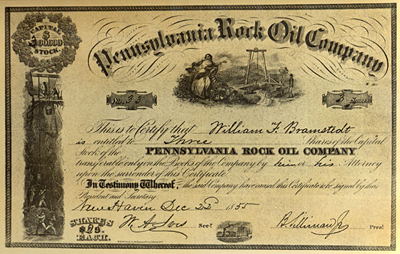
Considered America’s first petroleum exploration company – the Pennsylvania Rock Oil Company of New York – incorporated in 1854. It reorganized as Seneca Oil Company of New Haven Connecticut in 1858.
The advent of cable-tool drilling introduced the wooden derrick into the changing American landscape. The technology applied same basic idea of chiseling a hole deeper into the earth.
Using steam power, a variety of heavy bits, and clever mechanical engineering, cable-tool drillers continued to become more efficient. (Learn more Making Hole – Drilling Technology.)Investors in the first U.S. oil company would be rewarded in the summer of 1859 when a former railroad conductor hired by the Seneca Oil Company of New Haven, Connecticut, used innovative technologies to complete the first U.S. commercial oil well.
News spread quickly about the viscous, easily refined petroleum (from the Latin “petra,” rock, and “oleum,” oil). The Pennsylvania oil well that launched America’s petroleum age was 69.5 feet deep.
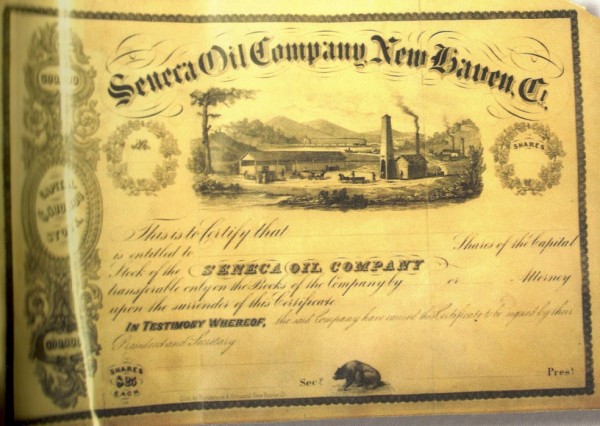
Organized by former Pennsylvania Rock Oil Company investors from New Haven, Connecticut, the Seneca Oil Company will drill the first commercial U.S. oil well in 1859. Image courtesy William R. Brice/Pennsylvania Historical and Museum Collection.
Coal Oil fuels Lamps
In the early days of America, when the sun went down, there was only dim light to resist the darkness. Candles could be made at home or manufactured, and other animal and vegetable oils could also be used as makeshift illuminants.
To extend day into the night, entire industries were born, including whaling. Whale oil could be burned in everyday lamps, and by 1846 a fleet of more than 700 ships sailed in search of this bounty. But men could work all day and not earn enough for a single pint of whale oil.
The most popular fuel was camphene, a highly volatile mixture of turpentine and alcohol. It was cheaper than whale oil, but often started deadly fires. For most people, when the sun went down, the day was done.
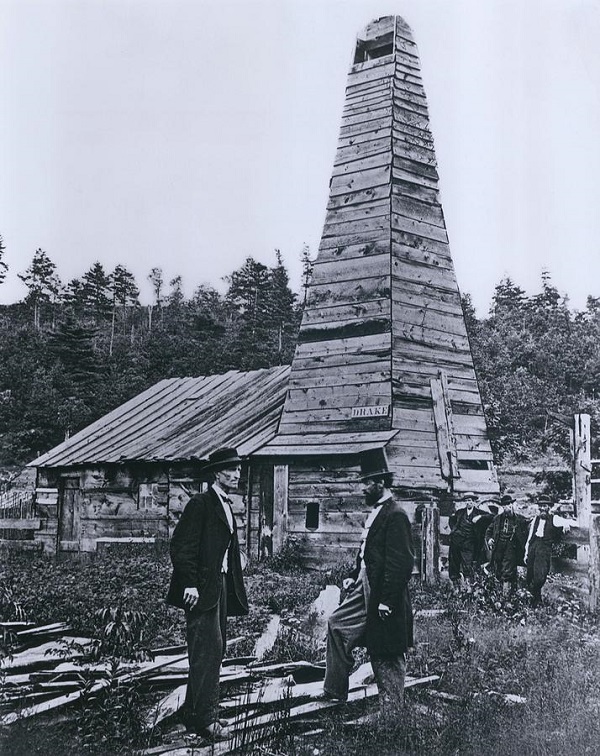
After fire destroyed his well two months after it found oil along Oil Creek, Pennsylvania, Edwin L. Drake rebuilt at the original site. Drake, right, stands with his friend Peter Wilson of Titusville. Photo courtesy Drake Well Museum.
Then, in the early 1850s, a Canadian chemist introduced a revolutionary new lamp fuel. Abraham Gesner’s patent read, “I have invented and discovered a new and useful manufacture or composition of matter, being a new liquid hydrocarbon, which I denominate Kerosene.”
Gesner patented his “Improvement in Kerosene Burning-Fluids” — realizing the usefulness of kerosene as a cleaner-burning fuel in lamps to replace whale oil. Because his new lighting fluid was extracted from coal, consumers called it “coal oil” as often as they called it kerosene. The inexpensive fossil fuel for lamps would illuminate the world.
Two years before the Civil War, more than 30 companies used Gesner’s process to produce the new coal oil. The fuel was easy to produce — and could be burned in existing lamps (and replace dangerous camphene lamps). The U.S. Patent Office recorded almost 250 different patents for all manner of lamps, wicks, burners, and fuels to meet America’s growing demand for illumination.
The Canadian chemist’s revolutionary coal-based product soon got a competitor from an unexpected source: a patent medicine.
Kier’s Petroleum Curative
About the time when Gesner invented kerosene, Mrs. Samuel Kier of Pittsburgh, Pennsylvania, contracted consumption (today known as tuberculosis), a dreaded killer of millions in the 19th century. Her husband, Samuel Kier, dosed her with a popular cure-all bottled in Kentucky and known as “American Oil,” which sold for 50 cents a pint.
When his wife’s health seemed to improve, Kier noted that the medicine was made from the same black substance that often contaminated his Pennsylvania brine wells. Always an entrepreneur, Kier soon began skimming oil from natural seeps and packaging his own bottles of a curative for all manner of aches and pains.
Kier started a refining business in Pittsburgh and began selling his distilled oil labeled as “Kier’s genuine petroleum! Or rock oil! A natural remedy, Procured from a Well 400 feet deep, and possessing wonderful Curative Powers in diseases.”

Ceiling paintings display scenes of the industry’s earliest stories in the Titusville Trust Building, which opened in 1919. The Drake portrait by artist Alfred Valiant depicts the pioneer oilman flanked by two men holding five-foot cable tools – symbols of early oilfield technology. Photos by Bruce Wells.
Kier patent medicine newspaper ads featured brine-well wooden derricks that would soon inspire another entrepreneur to wonder if the same apparatus could be adapted to extract quantities of rock oil from which kerosene could be distilled.
Learning of Kier’s flourishing Pittsburgh refinery selling distilled “carbon oil,” George Bissell, a New York lawyer, saw a business opportunity. Bissell knew that near Titusville was a site of prolific petroleum seeps (see George Bissell’s Oil Seeps).
Bissel formed the Pennsylvania Rock Oil Company and hired Yale Professor Benjamin Silliman to prepare an analysis of Titusville’s oil. A positive assessment and Professor Silliman’s highly prized endorsement would be a powerful lure to venture capitalists and potential investors. When the professor delivered a resounding endorsement, investors were convinced.

Canadian chemist Abraham Gesner in 1855 received a U.S. patent for a process to distill coal into kerosene. Artwork from a Canadian commemorative stamp.
The Pennsylvania Rock Oil Company of New York (considered the first American oil company) was soon followed by the Seneca Oil Company of New Haven, Connecticut, as the investors maneuvered for maximum business and tax advantage.
Father of the Oil Industry
Seneca Oil hired Edwin Laurentine Drake (1819-1880), a former train conductor, who was an acquaintance of one of the investment partners. It helped that Drake’s railroad experience allowed free train passage to and from New Haven and remote northwestern Pennsylvania.
Company executives often addressed their letters to “Colonel” Ewin L. Drake in an effort to bolster his reputation in Titusville, where drilling took longer than anticipated, despite using a six-horsepower steam engine and cable-tool drilling rig. As local opinions grew more skeptical, he overcame technical challenges.
In fact, Drake pioneered several new drilling technologies, including a method to protect the integrity of the well bore.
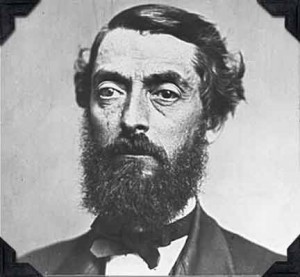
Edwin L. Drake invented a method of driving a pipe down to protect the integrity of the well bore. Photo from Drake Well Museum Collection.
“Drake faced difficulties from the beginning, the known methods of drilling for oil at the time only ended in failure,” historian Urja Davé explained in 2008. “He spent five months trying to recover oil, and people had lost their trust in him and some began calling him ‘Crazy Drake.’ Even his primary driller, William ‘Uncle Billy’ Smith, also began to feel dejected.”
Drake also became an inventor, Davé noted in “Edwin Drake and the Oil Well Drill Pipe” for the Pennsylvania Center for the Book. The father of the U.S. industry, “invented a ‘drive pipe’ or ‘conductor,’ an invention he unfortunately did not patent,” Davé proclaimed, adding:
In order to overcome the hurdles before him, he invented a “drive pipe” or “conductor,” an invention he unfortunately did not patent. Accordingly to The Daily Picayune, “Mr. Drake conceived the idea of driving a pipe down to the rock through which to start the drill.” “Uncle Billy” used Drake’s invention, drilling an average of three feet per day through rock and shale.
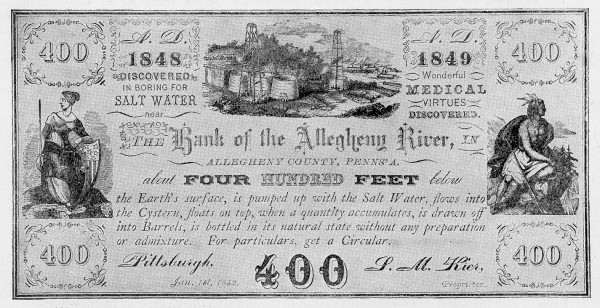
Samuel Kier’s patent medicine advertisements featuring brine-well wooden derricks are remembered for inspiring industrialist George Bissell to wonder if the same apparatus could be adapted to extract quantities of rock oil — from which highly prized kerosene could be distilled.
On a hot Saturday afternoon, after the cable-tool bit had reached 69.5 feet deep, “Uncle Billy” visited the site and noticed oil floating on top of the water in the hole. Drake borrowed a kitchen water pump to retrieve the oil. Drake’s first customer would be Sam Kier, who paid about $20 per barrel for oil delivered to his Pittsburgh refinery. The resulting “Carbon Oil” fuel for lamps sold for almost $40 dollars.
August 27, 1859, became a date on which the world changed, according to William Brice, Ph.D., professor emeritus of geology and planetary sciences at the University of Pittsburgh at Johnstown. “Drake’s Folly,” was not such a folly after all, because Drake had shown oil could be found by drilling for it.
“Drake is known as the ‘father of the petroleum industry’ because the technology he devised revolutionized how crude oil was produced and launched the large-scale petroleum industry,” noted Brice, author of the 2009 biography, Myth, Legend, Reality – Edwin Drake and the Early Oil Industry.
“About part of his life we know a great deal, while other parts of it are more obscure, but it was an interesting life, and his actions changed our modern world forever,” Brice added.
“Although Drake was born in Greenville, New York, March 20, 1819, to Lyman and Laura Drake, during his early childhood his family moved to another farm near Castleton, Vermont,” Brice reported. “Of his early education we know very little, though it is assumed he had a standard (for that time) country school education in Castleton.”

Visitors to the Drake Well Museum along Oil Creek in Titusville can tour a replica of the Edwin Drake’s cable-tool derrick and steam-engine house. Photo by Bruce Wells.
According to Brice, prior to becoming a conductor for the New York & New Haven Railroad, Drake worked in the dry goods business in New York. “No doubt this 25 year old, 6 feet 1 inch man in his new suit cut quite a figure as he walked along Broadway with a jaunty step and a smile and tipping his top hat to the ladies he passed.”
Drake met Philena Adams from Springfield, Massachusetts, and they were married on December 16, 1845, adds Brice. Their first son, Arthur, was born in 1847, but he died a little over a year later. A second son was born in 1849, but he, too, only lived a few months.
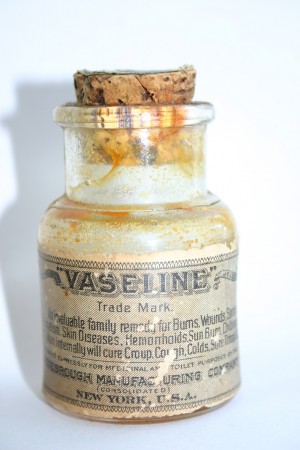
A popular early petroleum products was Robert Chesebrough’s balm, “petroleum jelly,” sold as “Vaseline.” Photograph from Drake Well Museum Collection.
During these tragedies, in 1849 Drake resigned from the Boston & Albany line to become a conductor on the New York & New Haven Railroad. When his wife died in 1854, Drake and his surviving child, a four-year-old son, moved to New Haven – where he became acquainted with George Bissell.
Drake re-married three years later to Laura Dowd, sixteen years his junior, in 1857. During this summer, illness prevented him from carrying on with his railroad job – but he retained the privileges of a train conductor, including free travel on the railroads.
By 1858, the Drake family found themselves living in Titusville. While there, Drake and his Seneca Oil Company investors began their search petroleum.
“Even though the use of petroleum dates back to the first human civilizations, the events of that Saturday afternoon along the banks of Oil Creek near Titusville, Pennsylvania, provided the spark that propelled the petroleum industry toward the future,” Brice proclaimed.
Following his famous oil discovery, Drake became a justice of the peace in 1860 before illness would force him to quit and leave Pennsylvania. After several years of financial hardship, Drake and his family returned to Titusville with little money and with his health failing.
In 1873, a group of Titusville residents convinced the general assembly to provide the Drake family an annual $1,500 pension.

A monument to Edwin Drake was dedicated in 1901 in Woodlawn Cemetery in Titusville. It was refurbished a few years after the 2009 sesquicentennial of his historic well. Photo by Bruce Wells.
Drake died in Bethlehem, Pennsylvania, on November 9, 1880. His remains were later moved to the Woodlawn Cemetery in Titusville.
In 1902, Standard Oil Executive Henry Rogers commissioned a statue for his burial site. The Drake monument — including a bronze statue by Charles Henry Niehaus – was dedicated on October 4, 1901. Known for his philanthropy, Rogers financed his friend Mark Twain’s last world tour, funded many schools and universities, including the Tuskegee Institute, and paid for Helen Keller’s education at Radcliffe.

William R. Brice, professor emeritus in geology and planetary science at the University of Pittsburgh at Johnstown, published a Drake biography in 2009.
The Drake monument was refurbished and rededicated in 2011. His original drilling site at Oil Creek has been a National Historic Mechanical Engineering Landmark with stone and plaque noting that by drilling of well, Drake began the modern petroleum industry. The plaque adds:
A series of revolutionary technological changes, unforeseen even by the most prophetic, followed. An emerging source of concentrated energy and abundant chemical compounds, petroleum supported sweeping changes in our modes of illumination, power development, transportation, and industrial chemistry. Few events in history have so transformed the face of civilization.
In addition to leading to the new science of petroleum geology, Drake’s discovery arrived at a good time for U.S. industrial manufacturers; in addition to kerosene lighting, vast numbers of new types of machines needed oil for lubrication.
More useful products followed, including the invention of a 22-year-old chemist from New York City.
In 1865, Robert Chesebrough visited Titusville’s oilfields before returning to his Brooklyn laboratory to experiment with a waxy substance that clogged well-heads. Chesebrough later patented a method that turned the paraffin into a balm; he called it “petroleum jelly.” Chesebrough in 1872 patented a new product, Vaseline (learn more in A Crude History of Mabel’s Eyelashes).
During a celebration of the 100th anniversary of Drake’s discovery on August 27, 1959, the U.S. Postal Service issued 801,859 commemorative stamps mailed from and cancelled in Titusville (see Centennial Oil Stamp Issue). Many of these “first day of issue” stamps included a special cachet illustration, “Born in Freedom, Working for Progress,” by artist Norman Rockwell. Almost 116 million of the four-cent stamps were issued.
By the 150th anniversary in August 2009, the U.S. oil and natural gas industry had drilled more than four million wells when a postal service advisory committee declined requests for a commemorative stamp.

Curator Susan, at left, leads a tour of the Drake Well Museum’s grounds. Exhibits tell the story of the beginning of the oil industry with operating machinery and historic building. Photos by Bruce Wells.
The original tools used to drill the first American oil well can be found at the Drake Well Museum and Park in Titusville. An exact replica of the cable-tool derrick and engine house stand today on the original site along Oil Creek. The museum also preserves thousands of photographs and artifacts from Pennsylvania’s “Valley that changed the World.”
_______________________
Recommended Reading: Myth, Legend, Reality: Edwin Laurentine Drake and the Early Oil Industry (2009); Early Days of Oil: A Pictorial History of the Beginnings of the Industry in Pennsylvania
(2000); Trek of the Oil Finders: A History of Exploration for Petroleum (1975); The Prize: The Epic Quest for Oil, Money & Power (1991). Your Amazon purchase benefits the American Oil & Gas Historical Society. As an Amazon Associate, AOGHS earns a commission from qualifying purchases.
_______________________
The American Oil & Gas Historical Society (AOGHS) preserves U.S. petroleum history. Become an AOGHS annual supporting member and help maintain this energy education website and expand historical research. For more information, contact bawells@aoghs.org. © 2022 Bruce A. Wells. All rights reserved.
Citation Information – Article Title: “First American Oil Well.” Authors: B.A. Wells and K.L. Wells. Website Name: American Oil & Gas Historical Society. URL: https://aoghs.org/petroleum-pioneers/american-oil-history. Last Updated: August 21, 2023. Original Published Date: April 14, 2016.


